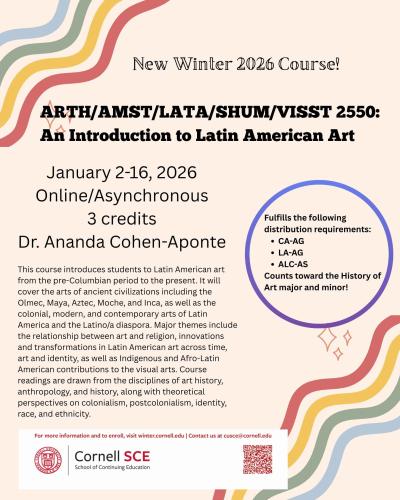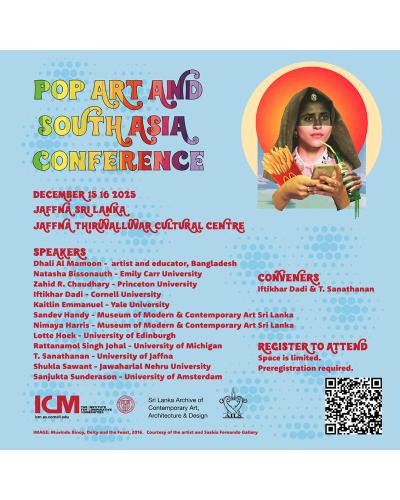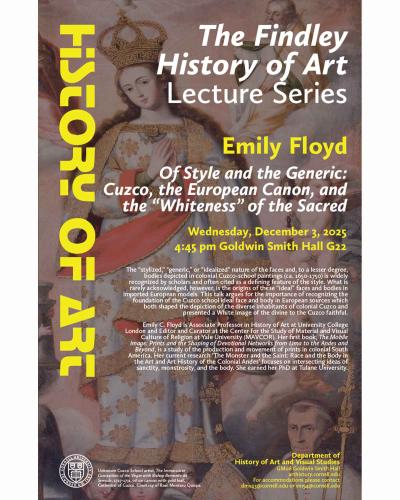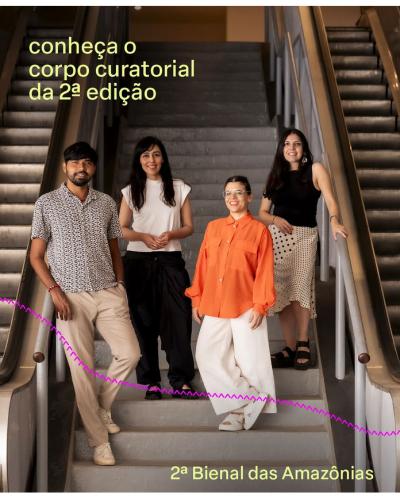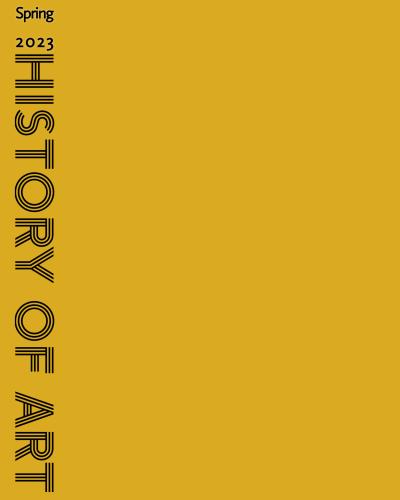History of Art & Visual Studies
SPRING 2023 Classes
VISST 2000 Introduction to Visual Studies (AMST 2000/ ARTH 2000/ COML 2000)
J.Rickard
T/R 1-2:15
Sections:
DIS 201 & 205 R 2:40-3:30
203 & 207 F 10:10 -11:00
202 & 206 R 3:45 – 4:35
204 & 208 F 11:20-12:10
This course introduces the field of Visual Studies. Visual Studies seeks to define and improve our visual relationship to nature and culture after the modern surge in technology and knowledge. It contains objects, images, and problems that lie beyond the Art History and experimental science, yet is grown from both cultures. It teaches the physical and legal limits of human, animal, and machine vision, how knowledge and power get into images, how spectacle drives the economy, and techniques of analysis that can deliver fresh perspectives across disciplines.
ARTH 2221 The Archaeology of Roman Private Life (ARKEO 2743/CLASS 2743)
A. Alexandridis
T/R 11:25 -12:40
What was it like to live in the Roman world? What did that world look, taste and smell like? How did Romans raise their families, entertain themselves, understand death, handle disease and interact with their government or nature? What were Roman values and how did they differ from our own? This course takes as its subject the everyday lives of individuals and explores those lives using the combined tools of archaeology, architecture and art, as well as some primary source readings. In doing so, it seeks to integrate those monuments into a world of real people, and to use archaeology to narrate a story about ancient lives and life habits. Some of the topics explored will include the Roman house, gardens, agriculture, bathing and hygiene, or sexuality.
This course will train your ‘visual literacy,’ that is the ability to identify, discuss and compare objects of material culture and to interpret them both as resulting from and actively shaping a broader historical context. You will also conduct more sophisticated analysis of issues central to the course’s concerns – theories and methods of analyzing material and written sources; questioning common notions of status, gender, sexuality, race, public and private etc. – in essay form, using specific monuments and/or objects as a basis for discussion.
ARTH 2805 Introduction to Asian Arts: Materials Worlds (ASIAN 2285/ VISST 2805)
K. McGowan & A. Pan
T/R 9:40 – 10:55
Trade in and to Asia proved to be a key force in creating our modern “globalized” world. The Indian Ocean and the China Seas converged on Southeast Asia, where a cosmopolitan array of ships from every shore plied their trade, set sail, and returned with the monsoon winds. People, goods, and ideas also traveled on camelback across the undulating contours of the Gobi Desert, connecting India, the Near East and Central Asia with China, Korea, and Japan. This course introduces students to the raw ingredients of things in motion, poised interactively in time and space, as material worlds collide. Wood, bamboo, bronze, clay, earthenware, ink, spices, textiles and tea - students will navigate sites of encounter at the Herbert F. Johnson Museum from pre modern to the present.
ARTH 3611/ 6611 Art of South Asia 1200–present (ASIAN 3382)
I. Dadi
M/W 2:45 – 4:00
This course surveys the art and architecture of South Asia since 1200 CE. We cover major developments over the last eight centuries, including the architecture of the Sultanate Period, Vijaynagar, painting and architecture in the Deccan and South India, Mughal art and architecture, and Rajput painting. We look at British period colonial art and architecture, the rise of nationalism and modernism in Indian art and the circulation of vernacular images, including posters and bazaar prints in the twentieth century. The recent globalization of South Asian contemporary art is also examined. Artistic movements are situated with reference to social, economic, and political developments.
ARTH 3803/ 6803 Urban Interfaces: Art, Architecture, and Urbanism in China at the turn of the 21st Century
N. Lin
T/R 2:45 – 4:00pm
How does art, architecture, and urban space interface with one another and what is the role of art in public space and public life? This course considers these questions within the context of China’s unprecedented urban transformation at the turn of the 21st century, paying attention to the ways in which art and architecture are at once resistant to and at the same time entangled with capitalist and governmental forces. From Beijing’s Tiananmen Square to Guangzhou’s skyscraper construction sites; from virtual cities to New York City—a center of the Chinese diaspora—we will look transregionally at how different types of urban spaces prompted new aesthetic forms and how such creative acts contributed, in turn, to the transformation of these very spaces.
ARTH 4155/ 6155 Topics in Latin American Art: Latin American Modernisms and Technology
(LATA 4155/ 6155, VISST 4155/ 6155)
M. Fernandez
M 2:40 – 4:35
The involvement of Latin American artists with modern media technologies dates at least to the late nineteenth century and has especially flourished in the last three decades. The canonical histories and criticism of Latin American art for the most part depict a history of artistic production in which technology plays a minor or invisible role. This construction of history reinforces the assumption that experimentation, innovation, and theorization in technological art are exclusive provinces of the developed world. As the history of art expands to include diverse areas of media arts and visual culture, the recognition of Latin American artists’ involvement with technology is not only overdue but also essential to the development of more diverse and rigorous understandings of both modernity and modernism.
ARTH 4160/ 6160 Topics in Colonial Encounters, Topic: Art and Identity in Colonial Latin America
(LATA 4160/ 6160, VISST 4160)
A. Cohen-Aponte
R 11:20 – 1:15
The colonial period in Latin America (circa 1521-1820s) witnessed the formation of one of the most diverse societies in the world. Labor regimes, religious activities, marriage alliances, and commercial contacts engendered by the Spanish colonial enterprise brought Spaniards, Africans, and Indigenous peoples into dynamic contact. This cross-fertilization of cultures resulted in the construction of new cultural categories and colonial identities whose reverberations continue to be felt into the present day. This seminar explores the role that visual culture played in the articulation of identity in Latin America. For the purposes of this seminar, “identity” can be loosely defined as the overlapping allegiances to which one ascribes, whether racial, cultural, gendered, religious, or community-based. The visual culture of colonial Latin America can reveal multitudes on the construction of self and community across temporal and geographical contexts. We will explore a variety of colonial Latin American objects and images, including paintings, textiles, and material culture. Our discussions of images will be guided by readings on hybridity, coloniality, cross-cultural exchange, and the early modern Atlantic world.
ARTH 4233 / 6233 Greek and Roman Art and Archaeology, Topic: Humans and Animals
(ARKEO 4233/7353, CLASS 4746/7746, FGSS 4233)
A. Alexandridis
W 2:40 – 4:35
As Greek and Roman societies relied fundamentally on hunting and agriculture, animals constituted a crucial point of reference in their conception of the world. Animals occupied different functions and roles for humans, such as foe or protector and companion, food and resource, sacrificial victim, subject and object of prodigies, but also status symbol, pet, object of entertainment, object of scientific study etc. We will look at how the different forms of interaction between humans and animals resulted from man's views of other species, but also how such interactions themselves helped shape these views. How did they eventually intersect with discourses on gender, age, class, and race? We will investigate written sources covering the whole range of literary genres; images; and archaeological material. Readings will also refer to the modern debate on the relationship between humans and animals.
ARTH 4351/6351 Problems in Byzantine Art, Topic: Portraiture (ARKEO 4351/ 6351, CLASS 4752/ 7752, MEDVL 4351/ 6351, NES 4351/ 6351, RELST 4351/ 6351, VISST 4351/ 6351)
B. Anderson
M 9:05 -11
Byzantine artists produced a wide variety of images that modern interpreters have recognized as “portraits.” These images illuminate individual identity and visual representation in Byzantium. On the one hand, the constituent elements of a portrait (such as physiognomy, gesture, dress, and attributes) illuminate cultural understandings of personhood. On the other hand, those elements are assembled and displayed through means (composition, medium, and context) that illuminate cultural understandings of images and their ability to extend personal energy. We will focus on the primary sources, including preserved monuments (manuscripts, mosaics, sculptures, etc.) and literary witnesses (epigrams, historians’ accounts, etc.), supplemented by selections from the secondary literature on identity, individuality, and subject formation in Byzantium.
SHUM 4680/ 6680 & ARTH 4620/ 6620 Art and the Remapping of the World
K. Presutti
T 2:40-4:35
What possibilities does art offer to challenge the primacy of mapping in visualizing our world? Maps allow us to move through space, but they do so by abstracting space to its barest aspects—an act of reduction that has historically served to eliminate Indigenous inhabitants, ecological entanglements, non-spatial elements, and countless other features of our lived environment. This course posits remapping as an act of repair, a means of correcting some of the reductive tendencies of maps. Moving between the history of cartography, particularly as it appears in Cornell's extensive Map Collection, and a study of artistic critiques of the map, we will develop a critical vocabulary for assessing cartographic practice and explore new tools for imagining it otherwise.
ARTH 4816/ 6816 Modern Chinese Art (also ASIAN 4473/ 6673, SHUM 4916)
A. Pan
W 9:05-11
China, a cultural giant of East Asia, made a passive entrance into modernity. With the advent of Western and American colonialism and imperialism, coupled with recent successes in westernization by the Japanese, Chinese artists had to redefine their roles as well as their visions. This turmoil bore witness to a vibrant beginning in modern Chinese art. Interactions between the Chinese themselves, and Chinese interactions with foreigners in the major cities of Shanghai and Beijing, fostered new directions in Chinese art and helped shape western visions of Chinese art history. Issues covered include: Chinese debates on western influence–their theoretical foundations and rationales; New visions for the future of Chinese art in the late 19th and early 20th centuries; Pluralistic approaches and arguments on “Chinese identity” in the modern era; Collecting art and the vision of history; The identity of traditional literati painters in the modern era-their roles, artworks, and deeds; Foreigners in China-the formation of major European collections of Chinese art, and the formation of “Chinese art history” in the West.
ARTH 4858/ 6858 Dancing the Stone
(also ASIAN 4456/6656, MEDVL 4858/ 6858, PMA 4358, VISST 4858)
K. McGowan
BY PERMISSION, W 12:25 – 2:20
This course examines the role of temples and their sculptural programs in South and Southeast Asia as creative stimuli for performative reenactments. Choreographic encounters between imagination and memory will be mapped as they occur at various points historically and politically in Java, Bali, Cambodia and India. Since architectural choreography implies the human body’s inhabitation and experience of place, the nature of ritualized behavior and its relationship to performance and politics will be explored spatially, both in organizing experience and defining or redefining identity on colonial, national, and diasporic margins. Bringing back the haptic sense (i.e. of feeling and doing at the same time) students will have the unique opportunity to balance the demands of learning a Balinese traditional dance while exploring performance traditions in historical perspective.

